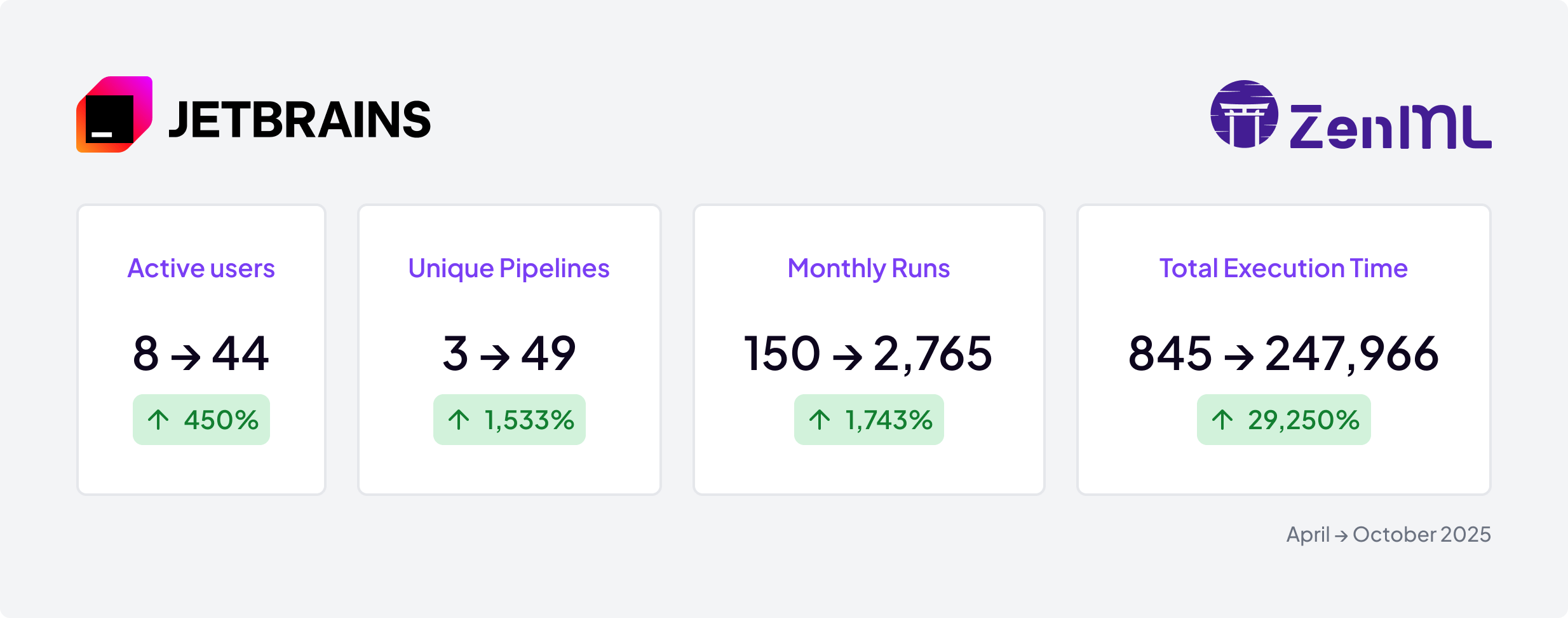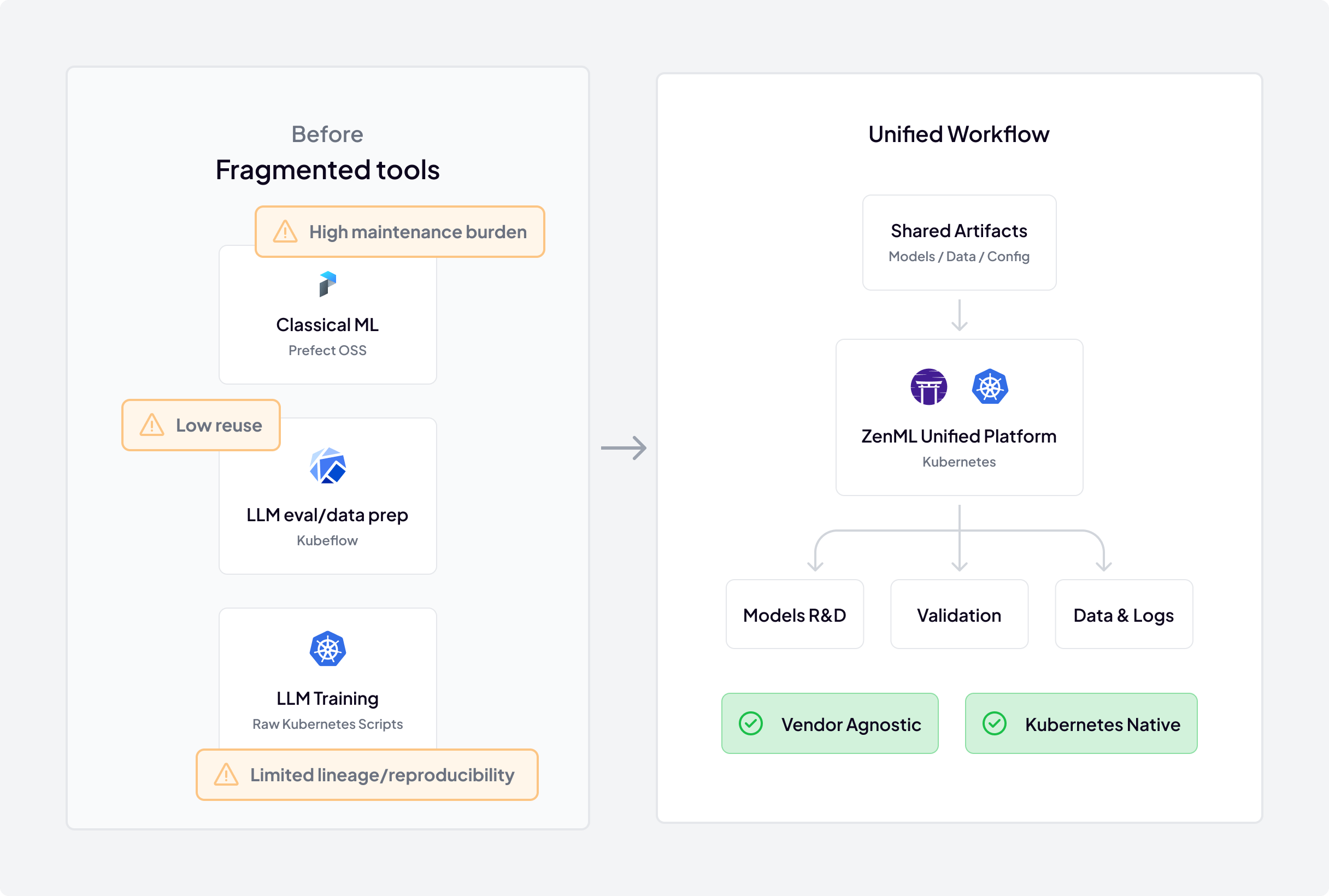
A phased migration from Kubeflow and Prefect OSS to a single platform now managing a 170% month‑over‑month execution growth and complex 3,000+ node agentic pipelines.


📊 Key Metrics of Change
Note: The +170% figure refers to the month‑over‑month change in total execution time from September to October 2025.
Before standardizing, JetBrains' MLOps team was managing a fragmented and costly collection of tools. This was not only inefficient but was creating a significant and growing maintenance burden at the same time. Different teams used different solutions for similar problems—Prefect OSS for classical ML and lightweight training, Kubeflow for LLM evaluation and data prep, and raw Kubernetes scripts for LLM training—which created a high-overhead environment where infrastructure support was fractured and best practices were impossible to enforce.
This technical fragmentation created deep organizational silos. With a ~200‑person AI organization—and around 100 hands‑on ML practitioners—there was no unified platform to track models from training to evaluation, making lineage and reproducibility a manual, detective‑like process. As a result, code reuse was nearly impossible, and valuable time was lost as teams independently solved the same problems, unable to build on each other's work.
Initially, the MLOps team’s mandate was to support multiple teams within a single department. Even within that boundary, teams followed entirely different rules and architectural patterns—from monorepos to dedicated repositories—making a one‑size‑fits‑all solution unrealistic. This diversity of environments and requirements made a one-size-fits-all solution impossible and which meant the current model was fundamentally unsustainable.

JetBrains ran a market-wide evaluation to find one platform that satisfied both advanced and casual users without increasing infra overhead. ZenML stood out on developer experience and platform fundamentals:

Implementation was a phased and strategic journey, not a "big bang" migration. After a successful proof-of-concept in early 2025, the JetBrains teams with support from the MLOps team began methodically migrating workloads and implementing new complex pipelines for agent use-cases and beyond.
They strategically targeted their most complex and widely-used "flagman" (flagship) pipeline from Kubeflow first. By proving the platform's value on this critical, high-visibility workload, they established best practices and built internal confidence. This strategy was a clear success, paving the way for wider adoption that grew from just 8 monthly active users in April to 44 by October.
The team now manages a highly sophisticated architecture on ZenML, tailored to their enterprise scale.
The successful migration and internal development efforts have translated into measurable, compounding gains for JetBrains. The platform's stability and feature set have become a powerful draw for internal teams.
The strongest proof of success has been the platform's rapid, organic adoption following internal advocacy. In a single month (September to October 2025), the number of monthly active users grew by 63%, driven by word-of-mouth and visible team successes. Concretely, unique monthly active users grew from 27 to 44 between September and October 2025 (+63% month‑over‑month), as additional teams started running real workloads. This demand is widespread, with a planned internal workshop on ML workflows attracting over 150 invites from across the organization, signaling massive interest in the new, standardized approach.
With a unified platform, JetBrains has unlocked significant technical victories. The MLOps team is successfully migrating complex workloads off of Kubeflow and Prefect OSS, eliminating a major maintenance burden and unifying their infrastructure. New platform capabilities like inline runtimes shorten feedback loops for simple pipelines by skipping per‑step container cold starts; the orchestrator still initializes as usual. Combined with completed stability improvements, this has shifted internal perception from early “low‑maturity” concerns to a stable, production‑grade platform with good standing internally.

The collaboration between JetBrains and ZenML has evolved from addressing initial infrastructure challenges to enabling future innovation. With a stable foundation, the focus is now on scaling the platform's impact across the entire company.
The partnership now includes deep collaboration on scaling best practices. Jointly-planned workshops for JetBrains' 150-person ML organization are designed to transfer knowledge efficiently, ensuring that teams can not only use the platform but also leverage its most advanced capabilities for complex AI workloads.
ZenML is now the standard default platform for new ML projects at JetBrains, reducing the overhead of selecting and configuring disparate frameworks. Adoption and momentum continues to expand, with a large team currently onboarding. This promises even more significant growth in the coming months.
With a stable and scalable foundation, the partnership is now focused on unlocking the next frontier of innovation. The MLOps team is no longer just managing complexity; they’re enabling simplicity at scale. The unified platform gives them the capacity to explore and productionize sophisticated agentic AI workloads and advanced model architectures, positioning JetBrains to stay at the vanguard of AI development.